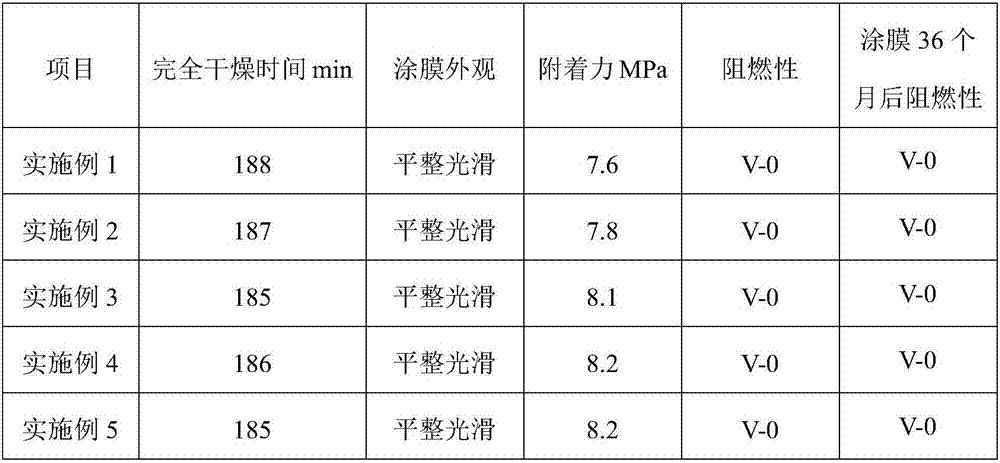Preparation method of flame-retardation paint
A flame-retardant coating, stirring and mixing technology, applied in the direction of fire-resistant coatings, coatings, etc., can solve the problems of flame-retardant performance degradation, flame-retardant coatings containing volatile harmful ions, etc.
- Summary
- Abstract
- Description
- Claims
- Application Information
AI Technical Summary
Problems solved by technology
Method used
Image
Examples
Embodiment 1
[0018] A preparation method of flame retardant coating, comprising the following steps:
[0019] (1) Stir and mix 5 parts by weight of silicate ester, 5 parts of maleic acid resin, 2 parts of propylene glycol methyl ether acetate, 1 part of sodium silicate and 3 parts of 2-phenylethyl acrylate, stir The speed is 120 rpm, and the stirring time is 20 minutes to obtain mixture 1;
[0020] (2) Add 0.5 parts of benzoyl peroxide, 1 part of pentaerythritol and 1 part of borosilicate glass powder to mixture 1, heat and keep it for 20 minutes at a heating temperature of 50°C, then add 1 part of microcrystalline cellulose, polyethylene 2 parts of diol 400, stir and mix,
[0021] The stirring speed of stirring and mixing is 150 rpm, and the stirring time is 10 minutes to obtain mixture 2;
[0022] (3) Add 3 parts of titanium dioxide, 1 part of powdered alumina and 60 parts of water to mixture 2, and grind until the particle size is less than 50 μm to obtain a flame-retardant coating. ...
Embodiment 2
[0024] A preparation method of flame retardant coating, comprising the following steps:
[0025] (1) Stir and mix 6 parts by weight of silicate ester, 7 parts of maleic acid resin, 2 parts of propylene glycol methyl ether acetate, 1 part of sodium silicate and 4 parts of 2-phenylethyl acrylate, stir The speed was 130 rev / min, and the stirring time was 22 minutes to obtain mixture 1;
[0026] (2) Add 0.6 parts of benzoyl peroxide, 1 part of pentaerythritol and 2 parts of borosilicate glass powder to mixture 1, heat and keep it for 25 minutes at a heating temperature of 56°C, then add 2 parts of microcrystalline cellulose, polyethylene 3 parts of diol 400, stirred and mixed, the stirring speed of stirring and mixing was 153 rpm, and the stirring time was 14 minutes to obtain mixture 2;
[0027] (3) Add 3 parts of titanium dioxide, 1 part of powdered alumina and 65 parts of water to mixture 2, and grind until the particle size is less than 50 μm to obtain a flame-retardant coati...
Embodiment 3
[0029] A preparation method of flame retardant coating, comprising the following steps:
[0030] (1) Stir and mix 7 parts by weight of silicate ester, 9 parts of maleic acid resin, 3 parts of propylene glycol methyl ether acetate, 2 parts of sodium silicate and 4 parts of 2-phenylethyl acrylate, stir The speed is 140 rpm, and the stirring time is 25 minutes to obtain mixture 1;
[0031] (2) Add 0.7 parts of benzoyl peroxide, 2 parts of pentaerythritol and 2 parts of borosilicate glass powder to mixture 1, heat and keep it for 24 minutes at a heating temperature of 55°C, then add 1 part of microcrystalline cellulose, polyethylene 4 parts of diol 400, stirred and mixed, the stirring speed of stirring and mixing was 155 rpm, and the stirring time was 16 minutes to obtain mixture 2;
[0032] (3) Add 4 parts of titanium dioxide, 2 parts of powdered alumina and 65 parts of water to mixture 2, and grind until the particle size is less than 50 μm to obtain a flame-retardant coating. ...
PUM
| Property | Measurement | Unit |
|---|---|---|
| Adhesion | aaaaa | aaaaa |
Abstract
Description
Claims
Application Information
 Login to View More
Login to View More - R&D
- Intellectual Property
- Life Sciences
- Materials
- Tech Scout
- Unparalleled Data Quality
- Higher Quality Content
- 60% Fewer Hallucinations
Browse by: Latest US Patents, China's latest patents, Technical Efficacy Thesaurus, Application Domain, Technology Topic, Popular Technical Reports.
© 2025 PatSnap. All rights reserved.Legal|Privacy policy|Modern Slavery Act Transparency Statement|Sitemap|About US| Contact US: help@patsnap.com

